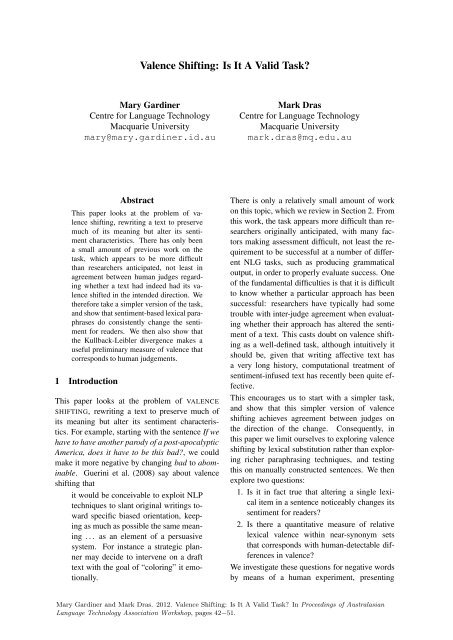Full proceedings volume - Australasian Language Technology ...
Full proceedings volume - Australasian Language Technology ...
Full proceedings volume - Australasian Language Technology ...
Create successful ePaper yourself
Turn your PDF publications into a flip-book with our unique Google optimized e-Paper software.
Valence Shifting: Is It A Valid Task?<br />
Mary Gardiner<br />
Centre for <strong>Language</strong> <strong>Technology</strong><br />
Macquarie University<br />
mary@mary.gardiner.id.au<br />
Mark Dras<br />
Centre for <strong>Language</strong> <strong>Technology</strong><br />
Macquarie University<br />
mark.dras@mq.edu.au<br />
Abstract<br />
This paper looks at the problem of valence<br />
shifting, rewriting a text to preserve<br />
much of its meaning but alter its sentiment<br />
characteristics. There has only been<br />
a small amount of previous work on the<br />
task, which appears to be more difficult<br />
than researchers anticipated, not least in<br />
agreement between human judges regarding<br />
whether a text had indeed had its valence<br />
shifted in the intended direction. We<br />
therefore take a simpler version of the task,<br />
and show that sentiment-based lexical paraphrases<br />
do consistently change the sentiment<br />
for readers. We then also show that<br />
the Kullback-Leibler divergence makes a<br />
useful preliminary measure of valence that<br />
corresponds to human judgements.<br />
1 Introduction<br />
This paper looks at the problem of VALENCE<br />
SHIFTING, rewriting a text to preserve much of<br />
its meaning but alter its sentiment characteristics.<br />
For example, starting with the sentence If we<br />
have to have another parody of a post-apocalyptic<br />
America, does it have to be this bad?, we could<br />
make it more negative by changing bad to abominable.<br />
Guerini et al. (2008) say about valence<br />
shifting that<br />
it would be conceivable to exploit NLP<br />
techniques to slant original writings toward<br />
specific biased orientation, keeping<br />
as much as possible the same meaning<br />
. . . as an element of a persuasive<br />
system. For instance a strategic planner<br />
may decide to intervene on a draft<br />
text with the goal of “coloring” it emotionally.<br />
There is only a relatively small amount of work<br />
on this topic, which we review in Section 2. From<br />
this work, the task appears more difficult than researchers<br />
originally anticipated, with many factors<br />
making assessment difficult, not least the requirement<br />
to be successful at a number of different<br />
NLG tasks, such as producing grammatical<br />
output, in order to properly evaluate success. One<br />
of the fundamental difficulties is that it is difficult<br />
to know whether a particular approach has been<br />
successful: researchers have typically had some<br />
trouble with inter-judge agreement when evaluating<br />
whether their approach has altered the sentiment<br />
of a text. This casts doubt on valence shifting<br />
as a well-defined task, although intuitively it<br />
should be, given that writing affective text has<br />
a very long history, computational treatment of<br />
sentiment-infused text has recently been quite effective.<br />
This encourages us to start with a simpler task,<br />
and show that this simpler version of valence<br />
shifting achieves agreement between judges on<br />
the direction of the change. Consequently, in<br />
this paper we limit ourselves to exploring valence<br />
shifting by lexical substitution rather than exploring<br />
richer paraphrasing techniques, and testing<br />
this on manually constructed sentences. We then<br />
explore two questions:<br />
1. Is it in fact true that altering a single lexical<br />
item in a sentence noticeably changes its<br />
sentiment for readers?<br />
2. Is there a quantitative measure of relative<br />
lexical valence within near-synonym sets<br />
that corresponds with human-detectable differences<br />
in valence?<br />
We investigate these questions for negative words<br />
by means of a human experiment, presenting<br />
Mary Gardiner and Mark Dras. 2012. Valence Shifting: Is It A Valid Task? In Proceedings of <strong>Australasian</strong><br />
<strong>Language</strong> <strong>Technology</strong> Association Workshop, pages 42−51.














